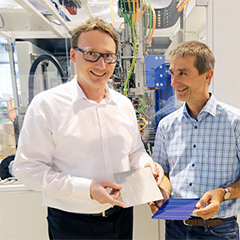The ECA process developed by teamtechnik for joining high-efficiency bifacial HJT (heterojunction) cells has proven successful in series production. Many leading module manufacturers whose production involves this technology are already opting for the Stringer TT1600ECA for their HJT solar modules.
ECA is an abbreviation for electrically conductive adhesive. In this technology, a conductive adhesive is applied to both sides of the cell, using screen printing. Next, light-capturing ribbons (LCRs) are positioned over the solar cells to connect them and form a string, and the adhesive is fully cured at temperatures of about 160 ºC. This process reduces the thermal and mechanical stresses on these sensitive cells and increases the reliability of the modules. ‘With this new gluing technology our HJT module customers are achieving an outstanding string quality, and without excessive lead times. Recently we installed a complete system, consisting of two ECA stringers and a layup application, and provided intensive training for the operators, all in just four weeks,’ reports Sven Kramer, Vice President Sales at teamtechnik’s Solar Technology division.
The Stringer TT1600ECA is designed specifically for use with electrically conductive adhesive (ECA) and allows process-reliable series production with high unit volumes. The production system joins HJT cells with light-capturing ribbons (LCRs) at a cycle rate of 2.25 seconds. The finished product is a solar module that is designed for extremely high performance and long life.



























